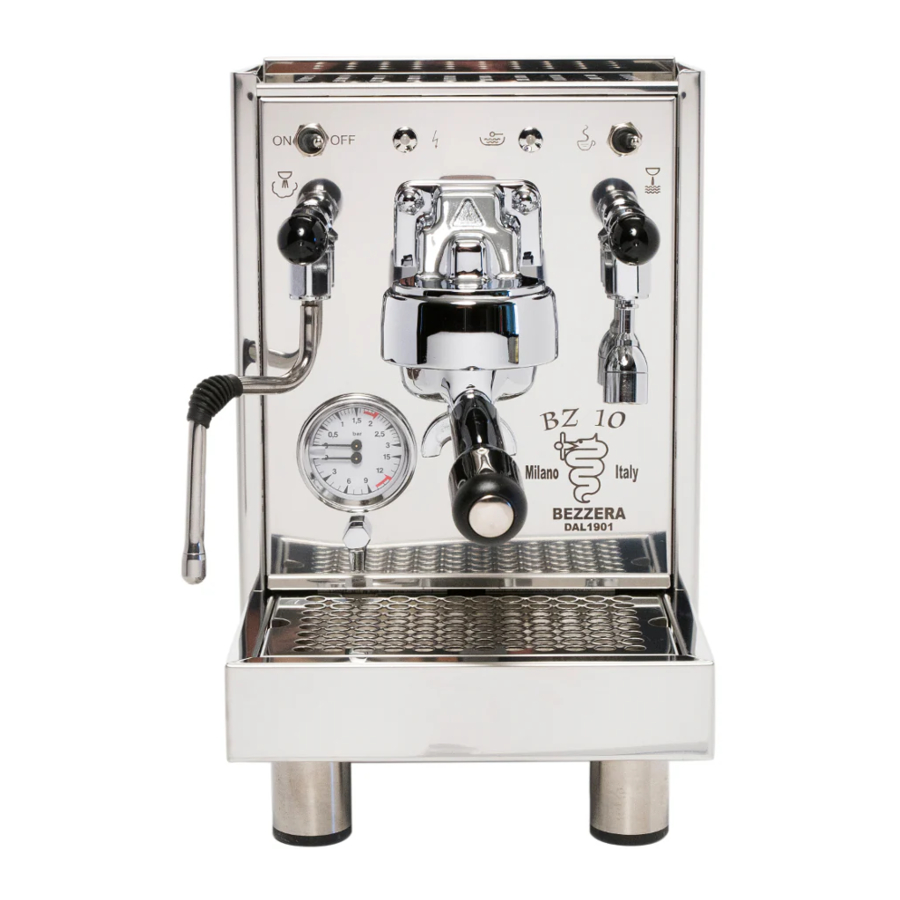
Advertisement
- 1 MACHINE DESCRIPTION
- 2 MACHINE INSTALLATION
- 3 MACHINE USE
- 4 MAINTENANCE
-
5
TROUBLE SHOOTING
- 5.1 No distribution of steam from specific tube
- 5.2 Leaks from filter holder
- 5.3 Difficulty in placing the filter holder on the attachment ring
- 5.4 Coffee flow is less than usual
- 5.5 Coffee flow is excessive
- 5.6 The coffee distributed is too cold
- 5.7 The coffee distributed is tepid
- 5.8 The coffee distributed is too hot
- 5.9 Coffee deposits on the bottom of the cup
- 6 WARNINGS
- 7 TRANSPORT
- 8 Documents / Resources

MACHINE DESCRIPTION
Description of working cycle
The water coming from the tank on the back of the machine, via a pump, passes through a over pressure valve regulated to 12 bar (1.2 MPa) and allows the boiler and the exchanger to be loaded. The boiler water, heated up through a resistor, heats up the exchanger water from which, thanks to a dip pipe, is convoyed to the group in order to brew the coffee by means of a valve electronically controlled.
Description of controls
(Fig. 01 - Fig. 09)
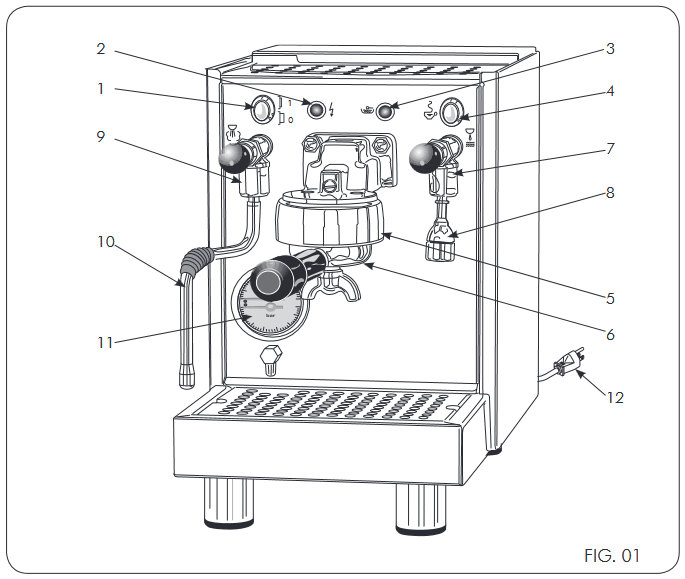
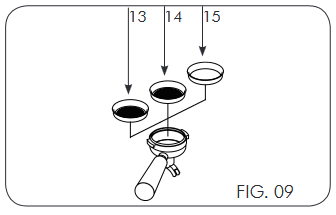
- Main switch
- Green light
- Yellow light
- Coffee distribution button
- Distribution unit
- Filter holder
- Water tap
- Hot water distributor
- Steam tap
- Steam nozzle
- Pressure gauge
- Electrical power cable
- 1 cup filter
- 2 cup filter
- Blind filter
Technical data
(Fig. 02)
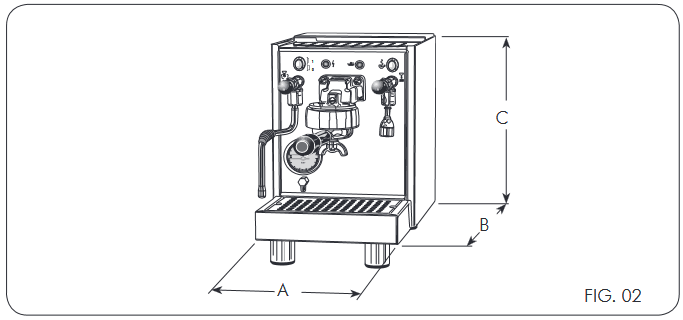
| Power supply | V~/Hz | 220 – 240V~ / 50-60Hz | 110 – 120V~ / 50-60Hz | |
| Resistance | V~ | 220 - 240 | 120 | |
| Nominal power | W | 1200 - 1400 | 1300 | |
| Resistance | W | 1100 - 1300 | 1200 | |
| Boiler | lt | 1,5 | ||
| Tank (S) | lt | 3,0 | ||
| Width «A» | mm | 250 | ||
| Depth «B» | mm | 425 | ||
| Height «C» | mm | 375 | ||
| Net weight | kg | 19 | ||
| Gross weight (box) | kg | 22 | ||
MACHINE INSTALLATION
Warnings
Installation must be carried out by qualified staff, according to the instructions supplied by the manufacturer and in compliance with applicable Laws.
The machine should be located and installed in a place where the use and maintenance are performed by qualified personnel. Can be used the machine in places used to staff kitchen areas in shops, offices and other working enviroments; farm houses; by clients in hotels, motels and other residential type enviroments; bed and breakfast type enviroments
Preparation of the plant for installation
Prepare the machine's support on a flat horizontal, dry, smooth, sturdy, stable surface positioned at such a height that the cup warming surface is over 150 cm from the ground.
Do not use water jets, neither perform the installation in places where water jets are used. In order to guarantee regular operation, the device must be installed in places where the temperature is between +5°C and +32ºC and the humidity does not exceed 70%.
If the machine is exposed to temperatures below + 0°C, proceed as follows:
- ensure that the machine has elapsed 24 hours in a place where temperature is higher than + 15°C before turn it on.
The machine is powered electrically and needs the following to function: - connection to the electrical power circuit
Connection to the electrical power circuit
- The connection to the mains electricity supply shall be executed by qualified personnel.
- The system shall be set in compliance with existing Standards and grounded.
The machine is supplied with power cable equipped with plug; in the permanent connection to mains electricity supply, between the machine and the power mains, interpose a protection omnipolar switch, with minimum opening between overvoltage-category III contacts, proportional to the charge and in compliance with Standards in force.
MACHINE USE
First machine start and water loading in the boiler
Pour water into the tank, checking that the aspiration pipe touches the bottom (Fig. 03).

- Use drinking water with water hardness in French degrees of about 15°F; never use hot water.
Insert the plug in the electrical socket. Turn the main switch (Fig. 01; pos. 1) to position ON, green light (Fig. 01; pos. 2) turn ON.
Water is automatically loaded into the boiler.

To restore working mode, turn off and turn on the machine again.
Heating
In order for the machine to reach the right temperature, with the pressure indicated on the boiler gauge (Fig. 01; pos. 11) between 1 and 1.2 bar (0.1 - 0.12 MPa), open the steam tap (Fig. 01; pos. 9) and discharge the steam 2 or 3 times into the discharge basin.
The yellow light (Fig. 01; pos. 3), if turned on indicates that the machine is working correctly, if turned off means insufficient water in the tank.
Preparing coffee
- Remove the filter holder (Fig. 01; pos. 6) from the distribution unit (Fig. 01; pos. 5).
- Load the filter holder with ground coffee, press the coffee down taking care to not dirty the edge of the filter holder.
- Reattach the filter holder in its housing.
- Start up coffee distribution by pressing the distribution button (Fig. 04; pos. a).
![Bezzera - BZ10 - Preparing coffee Preparing coffee]()
- Stop distribution when the desired quantity is reached, by pressing the distribution button again.
- Do not remove the filter holder full of coffee when the machine is working, as it is pressurised.
- Do not touch the metal part of the filter holder directly as it is hot.
- The standard doses for the filters are 10 grams for a dose and 20 grams for two doses.
Steam distribution
(Fig. 05)
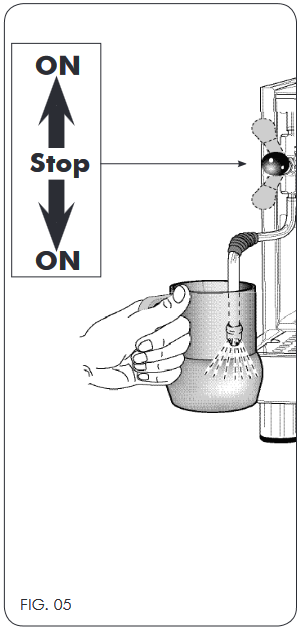
- To avoid liquids being sucked into the boiler, discharge the steam by turning the tap knob (Fig. 01; pos. 9).
- Insert the steam nozzle (Fig. 01; pos. 10) in the container of the liquid to be heated.
- Press down and hold the steam tap knob (Fig. 01; pos. 9), lifting the lever the tap will remain in open position (Fig. 05). The amount of steam distributed is proportional to the opening of the tap; the more the tap is opened, the more steam will be distributed.
- Once steam has been distributed, release knob, remove liquid container and clean the steam nozzle immediately with a damp cloth to remove heated liquid residues.
Do not touch the steam nozzle directly as it is hot.
Drawing hot water
- Place the water container under the nozzle (Fig. 01; pos. 8).
- Press down and hold the water tap knob (Fig. 01; pos. 7) to draw the amount of water required.
- Once water has been distributed, release the knob.
Do not touch the water distributor tap directly as it is hot.
Turning off the machine
Turn the main switch (Fig. 01; pos. 1) to position "OFF" and check that the green light has turned off. (Fig. 01; pos. 2)
Pressure gauge
(Fig. 10)
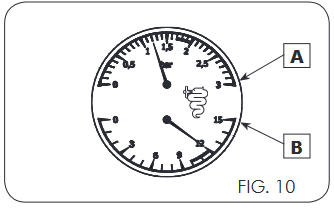
The machine is equipped with dual scale pressure gauge by which you can check the following pressures:
Boiler manometer (Fig. 10 - A) range 0~3 bar (0~0,3 MPa)
The boiler manometer indicates the boiler pressure.
Pressure gauge (Fig. 10 - B) range 0~15 bar (0~1,5 MPa)
The pressure gauge indicates the pump maximum pressure during operation. When the motor pump is stopped the manometer indicates "0".
MAINTENANCE
To allow the machine to work correctly, follow the maintenance instructions provided below.
Safety rules
Do not subject the machine to water jets. Disconnect the machine from the electrical power by turning the electrical power network omnipolar knife-switch lever to the resting position 0. Remove the plug and close the water interception tap before carrying out maintenance and/or cleaning work. If the machine is malfunctioning, do not attempt to repair it alone and call the technical assistance service immediately. If the electrical power cable has been damaged, turn off the machine immediately, turn off the water and call the technical assistance service. Do not replace it alone. Carry out cleaning/maintenance when the machine is cold, preferably wearing protective gloves.
Cleaning the machine
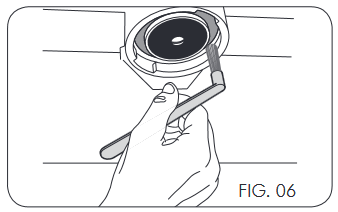
For the best results and in compliance with current regulations, change the water contained in the boiler and pipings at every daily startup of the machine.
These advices are indicative, the maintenance and cleaning schedules depend on the use of the machine.
After each use
- Clean the steam nozzle.
- Clean the filter holder and the filters.
Daily
- Clean the cup holding grid and the drain basin.
- Clean the body.
- Clean the group's gasket with the brush supplied.
- Wash the group as follows: hook the filter holder with the blind filter supplied to the group) and initiate output for a few times.
- Immerse the filter holder and the filters in hot water for a few minutes to dissolve the grease of the coffee, use a cloth or sponge to remove it.

Use water and neutral detergents to clean the tank after removing it. When finished rinse thoroughly. Replace the tank and insert the silicon tubes making sure that the suction pipe touches the bottom.
Safety thermostat - Manual rearming
The operation described below is only relevant to an installing technician who is authorised by the manufacturer.
While the machine is working, the boiler resistance may overheat and, cutting off power, sets off the safety thermostat that prevents any further damage to the boiler. To restore normal operations, resolve the malfunction that triggered the safety thermostat and restore normal conditions by pressing the red button (RESET) (Fig. 07).
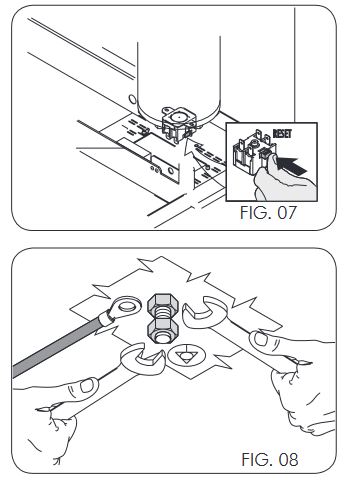
TROUBLE SHOOTING
| Problem | Diagnostics/Solution | Advice |
No distribution of steam from specific tube | The steam tube nozzle is blocked; unblock it using a pin. This problem is linked to the fact that the tip of the nozzle enters the milk. | Clean the steam nozzle after each use. |
Leaks from filter holder | Possible causes:
| Clean with the brush provided. If the problem should arise again, call a specialised technician. |
Difficulty in placing the filter holder on the attachment ring | The problem may be caused by the excessive dose of coffee in the filter holder. | Reduce the amount of coffee in the filter holder. (Standard doses for filters are 10 grams per dose). |
| Abnormal position of filter holder once placed on the unit. | Once locked onto the unit, the filter holder handle is further to the right than usual. The seal under the cup is worn. | Call a specialised technician to replace the seal under the cup. |
Coffee flow is less than usual | Coffee comes out in drops, distribution time is too long and the quality of the coffee is not good, it has a dark cream. Possible causes:
| In cases 1-2-3, the problem can be solved by adjusting the grinding and/or dosage of the coffee. In case 4, a technician must be called. In case 5, clean the filter or replace it. |
Coffee flow is excessive | The coffee is distributed too quickly and the cream is lighter than usual. Possible causes:
| Alter the coffee grinding and/ or dosage. |
The coffee distributed is too cold | Possible causes:
| In case 1, keep the filter holder assembled on the unit. In case 2, alter the coffee grinding. In cases 3 - 4, call a specialised technician. |
The coffee distributed is tepid | The coffee distributed is tepid, even if the pressure is found to be normal, between 1 and 1.2 bar (0.1 - 0.12 MPa). In this case, pressure monitoring is fictitious. | Call a specialised technician to check the airhole valve. In the meantime, however, in order to use the machine, open the steam tap (Fig. 01; pos. 9), the boiler pressure will go down to zero, and this will cause the resistance to step in and increase the temperature. Carry out this operation daily when turning on the machine. |
The coffee distributed is too hot | Possible causes:
| In case 1, call a specialised technician. In cases 2-3, restore the machine's cooling conditions. |
Coffee deposits on the bottom of the cup | Possible causes:
| Case 1 can be solved by correctly adjusting the coffee mill. In case 2, clean the filter holder or replace the filter. In case 3, a technician must be called. |
WARNINGS
General warnings
- The electric and water systems must be set up carefully by the user, according to what indicated in "Machine installation" booklet.
- The installer cannot absolutely modify the existing system set up by the user.
- This instructions booklet represents an integral part of the machine and must be read carefully by the user prior to use the machine.
- Store the booklet for future consultations.
- The machine must be delivered without water inside the boiler, in order to avoid possible damages caused by frost.
- Set up the ground connections of the electric system.
- Do not touch the machine with humid and/or wet hands and feet.
- Do not use the machine bare feet.
- Do not connect the feeder cable to movable extension cords and similar.
- Do not disconnect the machine from the electrical power by pulling the electrical power cable.
- Do not use the machine if the feeder cable is wound up.
- This appliance is not intended for use by persons (including children) with reduced physical, sensory or mental capabilities, or lack of experience and knowledge, unless they have been given supervision or instruction concerning use of the appliance by a person responsible for their safety.
- Children should be supervised to ensure that they do not play with the appliance.
- To avoid water infiltrations inside the machine, place the cups on the cup warmer with the hollow side facing the top.
- The machine is not intended for outdoor use.
- The following symbol indicates the danger of burns.
Foreseen use
The BZ10 espresso coffee machine was designed to make espresso coffee, produce hot water and prepare tea, camomile tea and other infusions, produce steam and heat drinks (milk, hot chocolate, cappuccino, punch etc.).
This machine was designed only and exclusively for the uses as above.
All other uses must be considered improper and therefore forbidden by the manufacturer. The manufacturer cannot be held responsible for damage caused by the improper use of the espresso coffee machine.
TRANSPORT
Packing
The BZ10 espresso coffee machine is wrapped in polyurethane foam and then packed in cardboard boxes.
- After removing the machine from the packing, check that it is whole and make sure that it has all fittings.
- Packing materials must not be left within children's reach and must be disposed of at the correct dumps.
- If the machine is found to be damaged or some parts are missing, do not use the machine and inform the local dealer immediately.
Moving the machine
The espresso coffee machine can be moved using a forklift truck, transport pallets or manually.
Storage
The correctly packed machine must be stored in a dry environment, within a temperature range of +5°C to +30°C and with relative humidity of maximum 70%.
A maximum of four boxes can be piled on top of one another.
Documents / ResourcesDownload manual
Here you can download full pdf version of manual, it may contain additional safety instructions, warranty information, FCC rules, etc.
Advertisement

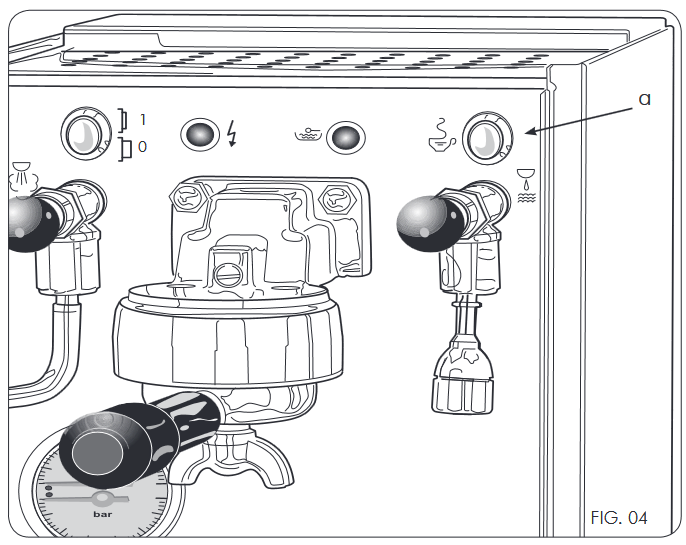





















Need help?
Do you have a question about the BZ10 and is the answer not in the manual?
Questions and answers